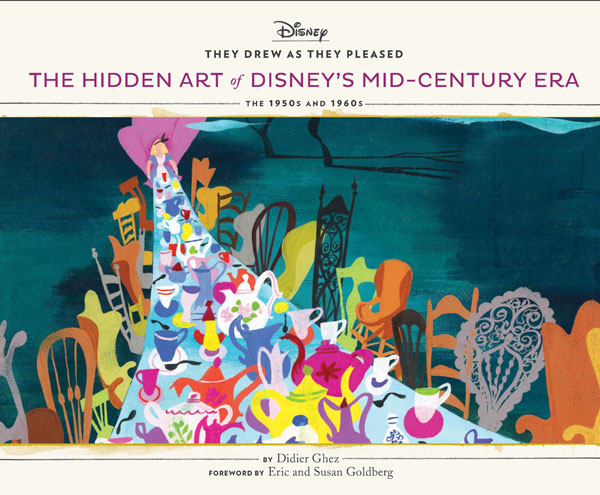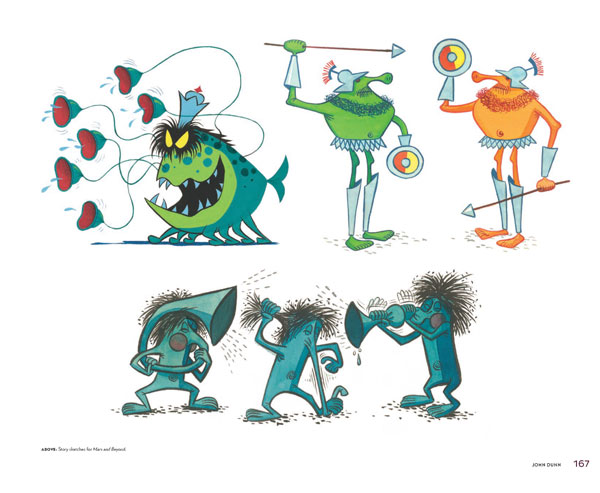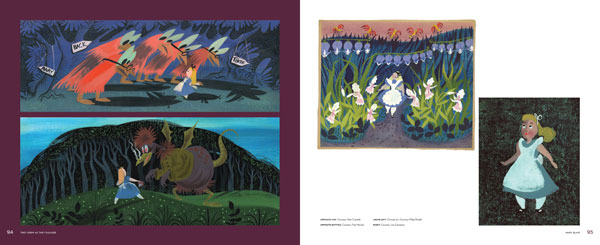I’m frequently amazed by the prolific output of author and Disney historian Didier Ghez. His Walt’s People series is up to 21 volumes of interviews with key figures in Disney history. And those titles are just part of the story. Ghez’s other major project is They Drew As They Pleased, an ongoing collection of striking books presenting concept artists from the ‘30s to the ‘90s. My understanding of Disney history barely scratches the surface of figures in these volumes.
The latest release from this series covers The Hidden Art of Disney’s Mid-Century Era: The 1950s and 1960s. Published by Chronicle Books, this hardbound title contains enough stunning art to work as a coffee-table book. Beyond those images, there are also interesting stories in the text portions. The 224 pages include details on challenges and successes of five talented artists from Disney history. Lee and Mary Blair, Tom Oreb, John Dunn, and Walt Peregoy created incredible work that is featured in vivid colors here. I quickly discovered that I had a lot to learn about each of them.
The foreword by animators Eric and Susan Goldberg sets the stage for the exciting contents. Theme park fans should note that Ghez barely touches on attractions within these pages; even Mary Blair’s work on “it’s a small world” only receives brief attention. There is some concept art from Peregoy’s work for EPCOT Center. The black-and-white drawings provide a striking glimpse at early ideas for the park. Peregoy created the Symphony of the Seed at The Land and designed the original balloons from that pavilion. I’d love to learn more about those projects. Ghez clarifies in the preface that this book focuses on their animation careers.
A Slow Transition Into A New Era
The backdrop for the art in this book is Walt Disney’s foray into television with his Disneyland TV program. Between that project and the monumental theme park that would open in 1955, Disney was focusing on a lot more than just films. The push-and-pull between new animation techniques and the classic look appeared throughout this era. Peregoy in particular struggled to find his place after Walt disliked his modern backgrounds for 101 Dalmatians. The internal conflicts throughout this book show a studio that was evolving yet still had a foot in the past.
Another surprise was the regular movement away from Disney and then back from this group. Mary Blair arrived at the studio in 1940 but resigned a year later to pursue illustration. It took the famous trip to South America to bring her back into the fold. Ghez depicts how important that journey was to both Lee and Mary Blair. Both worked on shorts for Saludos Amigos afterwards, and Mary’s art changed dramatically. This book helps explain what inspired her unique style and includes striking artwork to support her evolution. The “Mary Blair Look” remains stunning to this day, and it’s interesting to learn more about her background.
Beyond the Expected Disney Artists
I was not familiar with Tom Oreb or John Dunn prior to reading this book. It is refreshing to uncover Disney artists that I’d missed up to this point. Oreb’s character designs for Sleeping Beauty help bring such a distinctive look to that undervalued film. Beyond the art, Ghez describes the inner demons that hampered Oreb’s career. This also helps to explain why his work isn’t more known. Oreb’s characters have so much life to them, even the black-and-white pencil drawings.
Some of the most distinctive episodes from the early Disney TV series were the Tomorrowland entries. Ward Kimball involved John Dunn in creating silly gags that were essential to making Man on the Moon and Mars and Beyond succeed. Dunn’s color drawings included in this book showcase his humor and original style. Images of failed attempts to fly bring the right touches to present a show on history of flight.
My descriptions can barely hint at the wonders included within the fourth volume of They Drew As They Pleased. I have spent hours just paging through the incredible artwork provided throughout the book. Ghez offers the important backstory and then supports the descriptions with an extensive collection of images following the text. I can’t wait to go back and check out the other volumes. This book’s success reminds me once again how much there is to uncover from Disney’s past.
Learn more about They Drew As They Pleased, Vol. 4 at the Chronicle Books website. Photos in this post were used by permission.
Related Book Reviews
Walt Disney’s Melody Makers by Kathryn M. Price
Beyond the Wisdom of Walt by Jeffrey A. Barnes
True-Life Adventures by Christian Moran
This post contains affiliate links. Making any purchase through those links supports this site. See full disclosure.







Leave a Reply